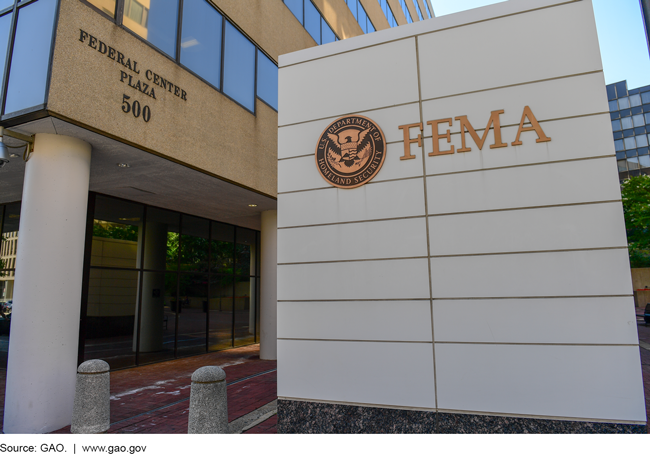COVID-19: FEMA's Role in the Response and Related Challenges
Fast Facts
The COVID-19 pandemic has resulted in over 100,000 reported deaths in the U.S., widespread unemployment, and an overall economic downturn. For the first time in history, major disaster declarations were issued simultaneously for all U.S. states, the District of Columbia, and U.S. territories.
We testified about our work on FEMA’s role in the COVID-19 response and what our prior work suggests about future challenges for this and other responses to nationally-significant biological incidents.
In our prior work we made several recommendations to FEMA, including that it do a better job collecting and analyzing lessons learned.

FEMA building
Highlights
What GAO Found
The Federal Emergency Management Agency (FEMA) Administrator, together with key officials from the Department of Health and Human Services, is responsible for managing the whole-of-nation COVID-19 pandemic response. As a primary agency responsible for managing the response, FEMA has worked in coordination with other federal agencies to increase the availability of supplies for COVID-19—including distributing supplies to states and others through Project Air Bridge in an effort to expedite distribution. FEMA's contract obligations in response to COVID-19 totaled about $1.6 billion as of May 31, 2020, with obligations for goods such as surgical gowns and N95 masks accounting for $1.4 billion, or 86 percent of that total.
GAO's recent report on the COVID-19 pandemic response and past work on other disasters has identified potential challenges FEMA faces in responding to the pandemic and any future nationally significant biological incidents. These challenges may be further complicated by the recent rise in COVID-19 cases and additional expected case increases in the fall.
Contracting. In December 2018, GAO found inconsistencies in how FEMA coordinated and communicated with states and localities on advance contracts—those that are established prior to disasters and are typically needed to quickly provide goods and services. GAO made recommendations to improve FEMA's efforts and it is taking actions to address this issue.
Medical supply acquisition and distribution. In June 2020, GAO reported on concerns about the distribution, acquisition, and adequacy of supplies from the Strategic National Stockpile and other sources. GAO will continue to monitor these issues through ongoing and future work.
Deploying disaster workforce. In May 2020, GAO reported on staffing shortages and other workforce challenges FEMA faced in recent disasters. The large number of declared COVID-19 disasters coupled with hurricane and wildfire seasons adds other potential challenges. GAO made recommendations designed to enhance the information FEMA officials have to manage the workforce, which FEMA agreed to implement.
After-action reporting. Analyzing lessons from the COVID-19 pandemic response may help FEMA and other agencies take corrective action for the remainder of this response and for potential future biological incidents. In May 2020, however, GAO reported that FEMA had not consistently completed prior after-action reports. FEMA agreed to implement recommendations designed to improve after-action reporting.
Interagency planning for biological incidents. In June 2020, GAO reported that the National Biodefense Strategy sets goals and objectives to help the nation prepare for and rapidly respond to biological incidents to minimize their effect and could drive interagency preparedness efforts. However, implementation was in early stages at the start of the pandemic, and in February 2020 GAO made recommendations designed to address key implementation challenges, including clarifying roles and responsibilities. As shown in the COVID-19 response, FEMA's role in these efforts will be critical. GAO will continue to monitor preparedness and strategy implementation.
Why GAO Did This Study
The COVID-19 pandemic shows how biological threats have the potential to cause loss of life and sustained damage to the economy, societal stability, and global security. During the pandemic, 57 major disaster declarations were simultaneously issued for all U.S. states, the District of Columbia, and U.S. territories—the first time in history this has occurred. FEMA had obligated about $5.8 billion for the response as of May 31, 2020.
This statement addresses (1) FEMA's role in managing the COVID-19 pandemic, including efforts to acquire and distribute critical medical supplies, as well as (2) potential challenges for this and other biological incident responses. This statement is based on products GAO issued from August 2003 to June 2020, as well as ongoing efforts to monitor contract obligations. For these products, GAO reviewed relevant presidential directives, statutes, regulations, policies, strategic plans, other reports, as well as federal procurement data; and interviewed federal and state officials, among others.
GAO provided a copy of new contract obligation information in this statement to the Department of Homeland Security for review.
Recommendations
GAO made many recommendations in prior reports designed to address facets of many of the challenges discussed in this statement. Federal agencies have not fully implemented all of these but, in many cases, have taken steps. GAO will continue to monitor these efforts.
